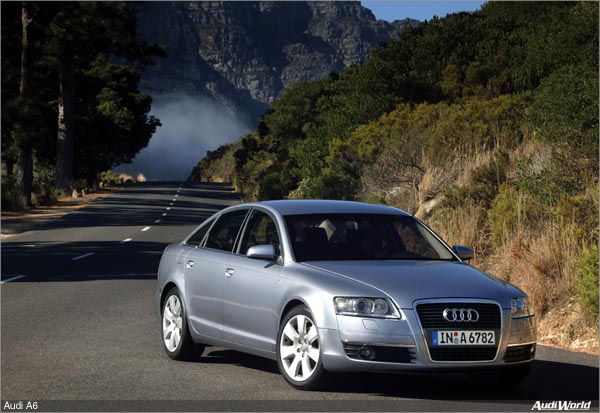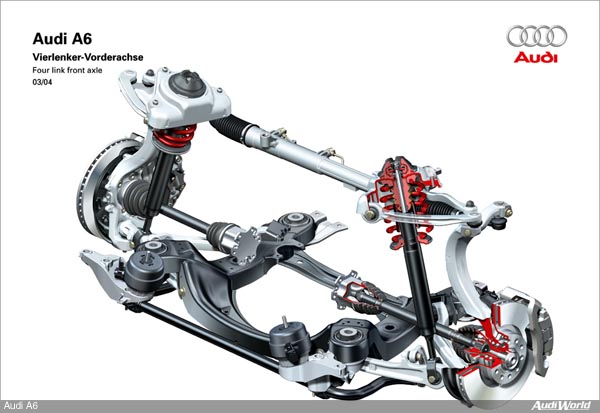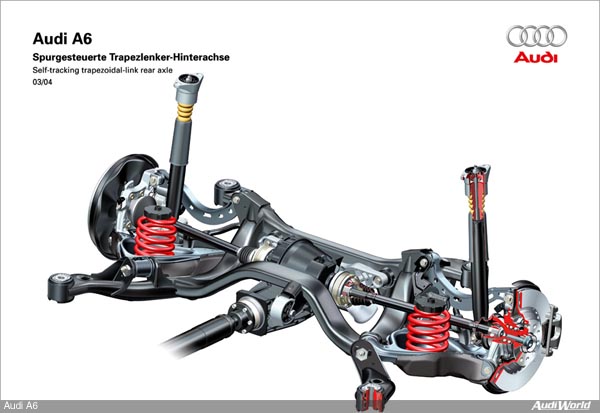The New A6: Audi Dynamic Suspension

The Audi dynamic suspension in the new A6 uses a technology which has already proven its sporting qualities under the most demanding and challenging conditions: the enhanced, Audi-designed four-link front suspension in combination with the self-tracking trapezoidal-link rear axle adopted from the Audi A8 – a combination featured both on the front-wheel-drive and quattro versions. The main components are made of lightweight aluminium serving to reduce unsprung masses. Not only has wheelbase been increased significantly (by 83 millimetres) compared with the previous model, the track of the car is also up at the front by 67 to 1612 millimetres and has been increased at the rear by 49 to 1618 millimetres – dimensions which set a new benchmark in this class. Weight distribution has also been optimised between the front and rear axles in the interest of even better handling and performance. On the road this means dynamic driving behaviour of the highest calibre, leaving the competition far behind. Indeed, these features place the new A6 side-by-side with the A8 lauded so positively by the press. For like the A8, the A6 clearly stands out as the sportiest car its class, also thanks to speed-dependent servotronic power assistance featured as standard and supplementing the precise handling of the new A6 by an even more precise and sensitive feedback to the steering.
Front suspension In relation to the passenger cell, the four-link front suspension of the new A6 has been moved forward by 83 millimetres compared with the previous model, thus ensuring far better axle load distribution with corresponding advantages in terms of driving dynamics. This change in proportions also looks good, making the front overhang far shorter and thus giving the entire car a much more compact appearance. Weight-optimised components help to reduce unsprung masses to a minimum: four aluminium track control arms in optimised design hold the wheels steadily in place, the axle subframe is configured as a shell panel structure, and the upper bearing block is made of cast aluminium. Lightweight technology is also used on the tube encompassing the anti-roll bar. A further point is the re-alignment of the car’s kinematics and elastokinematics serving to maximise both driving dynamics and motoring comfort. Particularly transverse stiffness benefits from the careful improvement of all track control mounts and bearings, extra-large rubber bushes within the axle subframe efficiently keeping any effects of the road out of the car’s interior. Steering The new Audi A6 comes as standard with electrohydraulic rack-and-pinion steering featuring speed-related power assistance, Audi servotronic. The objective in developing this very special steering was to provide the highest conceivable standard of sportiness and steering comfort all in one. With servotronic developed to an even higher level of perfection, steering forces when parking are reduced to a minimum, steering precision and a clear feedback at high speeds are improved to an optimum. A further advantage of servotronic is greater sensitivity around the central position of the steering and even more comfortable steering response. The steering kinematics have been optimised to keep the turning circle the same as on a comparable saloon with rear-wheel drive, despite the larger wheelbase and engine power going to the front wheels. The steering wheel of the new Audi A6 is adjustable electrically by 40 millimetres in a vertical direction and by 50 millimetres for reach. Significant attention to detail around the steering column and at its attachment points on to the body of the car serves to suppress vibrations on the steering wheel by almost 100 percent, offering the driver supreme smoothness at all times. The introduction of the new generation of A6 saloons also hails the advent of a new generation of steering wheels in the executive class. The “skeleton” of the steering wheel not visible to the driver is made of pressure-cast magnesium, a material combining very low weight with very high stiffness. The new three- and four-spoke steering wheels are recognisable at first sight on the airbag cover with the same characteristic trapezoidal shape as the single-frame radiator grille. Depending on the customer’s personal taste, the steering wheel rim is available either in wood or leather (the latter being standard). All variants of the steering wheel can be fitted as desired with either multifunction or tiptronic gearshift paddles directly on the steering wheel. And as an option, the four-spoke multifunction steering wheel comes with a heated steering wheel rim.
Rear suspension An outstanding achievement in technology already benefiting drivers of the Audi A8 and the new generation of the A4 is now also featured in the new A6: the self-tracking trapezoidal-link rear suspension fitted on both quattro and front-wheel-drive versions of this car. Hence, all new Audi A6 models come as standard with one of the most complex and efficient rear wheel suspension concepts currently available. The trapezoidal-link rear suspension gives all models first-class driving comfort and, at the same time, a level of driving dynamics quite unparalleled in the market. The trapezoidal-link structure is a shell configuration made of high-strength steel plate. Offering a high standard of torsional and flexural stiffness, the control arm takes up a great deal of the forces acting on the wheel, teaming up with the tie bar further to the rear in giving the axle its specific elastokinematic behaviour. The tie bar, in turn, is a lightweight steel plate structure. All wheel guidance components are pivoted via rubber/metal mounts on the elastically mounted axle subframe, vibrations on the axle therefore being efficiently dampened and kept away from the body of the car. Four extra-large, hydraulically damping mounts, in turn, also help to keep the body free of vibrations. The linear, high-strength steel springs rest on both the structure of the body and the trapezoidal arms. The two-sleeve gas pressure dampers, in turn, are connected to the wheel mounts to provide direct transmission of damper forces and ensure particularly sensitive damper response. Spring travel on the new Audi A6 is longer than on the former model, particularly in the interest of driving comfort. Lateral and directional stability on bumpy and undulating roads also benefits significantly from this improvement. The trapezoidal-link rear suspension is configured particularly to ensure supreme sporting characteristics as a significant objective in developing the new Audi A6. Consistent reduction of camber change as a function of spring travel improves the car’s directional stability, steering precision, and handling. The entire construction is conceived to provide neutral, moderately understeering driving behaviour when the car is driven to the limit. Available as an option from 2005: adaptive air suspension Like the Audi A8, the new A6 will be available as an option with adaptive air suspension as of 2005. This sophisticated system ensures an even more refined synthesis of sporting behaviour and supreme suspension comfort. A further advantage of air suspension is the speed-related reduction of ride height, the suspension lowering the entire body of the car for a low centre of gravity and significantly enhanced driving stability. At high speeds on the motorway, the reduction in ride height also improves the car’s aerodynamic qualities and reduces fuel consumption accordingly. And in response to the driver’s commands, adaptive air suspension provides extra ground clearance at low speeds as an important advantage on rough terrain. The new A6 comes with air spring struts on the front wheels, with the air spring gaiters arranged concentrically around the infinitely adjustable two-sleeve dampers. The air spring gaiters themselves are made of a special, multi-layer elastomer material with polyamide cord inserts to provide extra strength and stability. This special layer also takes up forces generated within the air springs. The big advantage of this structure is that the combination of individual layers gives the new A6 excellent roll characteristics and ensures sensitive spring response even to small bumps and jolts. On the rear axle the air springs and fully controlled dampers are separated from one another. The big advantage of this configuration is that it allows a large through-loading width and helps to keep the loading surface in the luggage compartment as low as possible. Through its design and configuration alone, air suspension provides a number of inherent qualities: the occupants benefit from pleasant and smooth ride conditions at all times, regardless of the load the vehicle is carrying. This is ensured by the additional air pumped into the springs when the car is carrying a high load, then being expelled again when the load is reduced. Spring stiffness therefore consistently adjusts to load conditions at all times. Brake system The brake system is carefully matched to the engine characteristics, the power and performance of the new A6 in general and to the individual models in particular. Even the entry-level model with the “smallest” engine comes with 16-inch brakes, the particularly powerful 4.2-litre eight-cylinder version featuring a 17-inch brake system. Brake disc diameter is 314 millimetres at the front on the A6 2.4 and 2.0 TDI and 321 millimetres on the 3.2 FSI and 3.0 TDI (4.2: 347 mm). Brake disc diameter at the rear, in turn, is 302 mm (4.2: 330 mm). Benefiting from these large dimensions, brake disc temperatures under high brake loads are reduced by more than 100o C, again in the interest of enhanced power and performance reserves. The brakes are operated via a dual rate servo giving the driver a sporting, firm feeling for the pedal and allowing excellent dosage of the brakes. Under such conditions, that is with light or medium pressure on the brakes, the brake servo boosts brake power by a factor of 5.5, again in the interest of particularly good brake force dosage. Above a defined point, the brake force transmission ratio is increased to a factor of 12, meaning that deceleration increases overproportionally to the forces applied on the brake pedal – obviously a significant advantage in the interest of a sporting style of motoring. Safety featured as standard: new generation of ESP All new Audi A6s come with the latest electronic stabilisation program, ESP 8 developed by Bosch. This highly sophisticated system comprises ABS brakes with electronic brake-force distribution EBD and hydraulic brake assist which automatically increases brake power when the driver applies the brakes in an emergency. ASR traction control interacts with the electronic differential lock EDL to provide efficient yaw control as the foundation for enhanced ESP safety. The system has been developed to an even higher standard in terms of both electronics and hydraulics. New pressure control ensures intervention of the ESP stability functions with maximum efficiency, particularly when the car is understeering, ESP thus cutting in very accurately and in accordance with specific requirements in each situation. Yet another new function is brake disc cleaning integrated in ESP. This new function helps to keep the brake discs dry on wet roads even when the driver does not apply the brakes for a relatively long time. To provide this effect, the brake linings are pressed against the discs under low hydraulic pressure at regular intervals, ensuring even more spontaneous brake response also under wet conditions. The new Audi A6 comes for the first time with a two-stage ESP deactivation button: pressing the button briefly, the driver is able to deactivate ASR traction control, which is sometimes necessary in deep snow or on gravel roads in order to set off and accelerate smoothly. Pressing the button a bit longer, on the other hand, the driver is able to deactivate ESP under all operating conditions in the interest of particularly dynamic performance with the car power-sliding at an angle under brake pressure, for example on the race track. Even then, however, the EDL and ABS functions remain operative. Electromechanical parking brake Following its successful debut in the Audi A8, the electromechanical parking brake is now also being introduced in the new A6, offering significant functional advantages over and above all the usual functions of a conventional handbrake. Operated by a pull/push button in the centre console, the electromechanical parking brake automatically applies brake forces at exactly the right level. In its operation, the system follows the general pattern of a conventional parking brake with which most drivers are well acquainted: briefly pulling the button, the driver activates the brake – pushing the button and pressing the brake pedal at the same time, the driver opens up the brake again. Telltales in the control unit and the instrument cluster present the current status of the parking brake at all times. The system is designed for a gradient of up to 30 percent. Whenever the gradient is even steeper, the driver is warned accordingly by a text in the display (“Vehicle too steep”). Serving as a kind of built-in setting-off assistant, the electromechanical parking brake makes it much easier to set off smoothly and without rolling back on gradients, without the driver being required to disengage the brake by hand: applying data such as the gear in mesh, the position of the accelerator pedal, engine speed and the angle of inclination, the system determines exactly the right time and the right rate for disengaging the parking brake. On cars with a manual gearbox the system also takes the position of the clutch pedal into account, the electronic “brain” automatically releasing the parking brake as soon as there is enough torque to move the vehicle forward. It almost goes without saying that the electromechanical parking brake features the emergency braking function prescribed by law in many countries: at a speed of more than 8 km/h, the driver is able to bring the car to a halt simply by pulling the parking brake button (for example if the foot brake system fails to operate). Within barely more than a second, this builds up a deceleration force of 8 m/sec2, far more than with a conventional handbrake. Wheels and tyres Even the four- and six-cylinder versions (up to 130 kW or 177 bhp) of the new Audi A6 come as standard with 7×16-inch alloy wheels running on 205/60 R16 tyres. The particularly powerful six-cylinder models come on 7.5 x16-inch wheels with 225/55 tyres, the 4.2-litre eight-cylinder model is fitted as standard with 17-inch wheels on 225/50 tyres. As an option the new Audi A6 is available with a choice of 10 different wheels measuring up to 18 inches and running on tyres up to 245/45 R18. In winter, in turn, the A6 driver has the choice of three wheels up to 7×17 inches in size and running on 225/50 tyres. All new Audi A6 models come as standard with Audi’s tyre mobility system but may also be fitted with a spare wheel as an option. A further option on board the new Audi A6 is a permanent tyre pressure monitoring system which observes the tyre pressure and temperature of each individual wheel. As soon as pressure decreases, the tyre receives an optical and an acoustic signal by way of the display in the instrument cluster even specifying the wheel involved. To provide this function, the signals from the wheel’s electronic control unit are transmitted wirelessly to the central vehicle electronics. This warning is provided in two stages: a pressure loss of more than 0.3 bar on one of the wheels activates a yellow warning requesting the driver to check tyre pressure in good time and pump up the tyre(s) accordingly. If tyre pressure is more than 0.5 bar below the limit required or if the tyre is losing pressure quickly, the message delivered to the driver comes in red, urging him to stop immediately and remedy the problem. The system is also able to take minor changes in temperature and pressure caused, say, by intense sunshine, hot air coming from the engine or unusual weight distribution of the car into account, thus avoiding a false alarm. Available as an option: PAX wheels Starting in 2005, the new Audi A6 will also be available with cast aluminium wheels with run-flat tyres – the so-called PAX system. These wheels and tyres allow the driver to continue for up to 200 kilometres at a top speed of 80 km/h, even if a tyre has suffered a complete loss of pressure. Benefiting from the PAX wheel’s run-flat qualities, the driver is able in the event of a puncture to reach an Audi workshop of his choice and is not required to change the wheel himself or call an emergency service. Clearly, this is the right kind of mobility appropriate for an executive car these days. Even without pressure, the tyre and wheel still provide a high level of residual comfort – the driver does not feel any undue, permanent impairment of driving characteristics caused by the loss of pressure. To draw the driver’s attention to an imminent puncture or a gradual loss of air in the tyre, the PAX system always comes in combination with automatic tyre pressure control keeping the driver informed of the condition of all wheels and reminding him to observe the maximum speed limit of 80 km/h in the event of a flat. The PAX system is made up of a special wheel rim, a suitably modified tyre, and the actual emergency component, that is a support ring almost in the middle of the wheel rim and extending out to either side. This technology ensures the tyre’s run-flat qualities even under a complete loss of pressure. |


